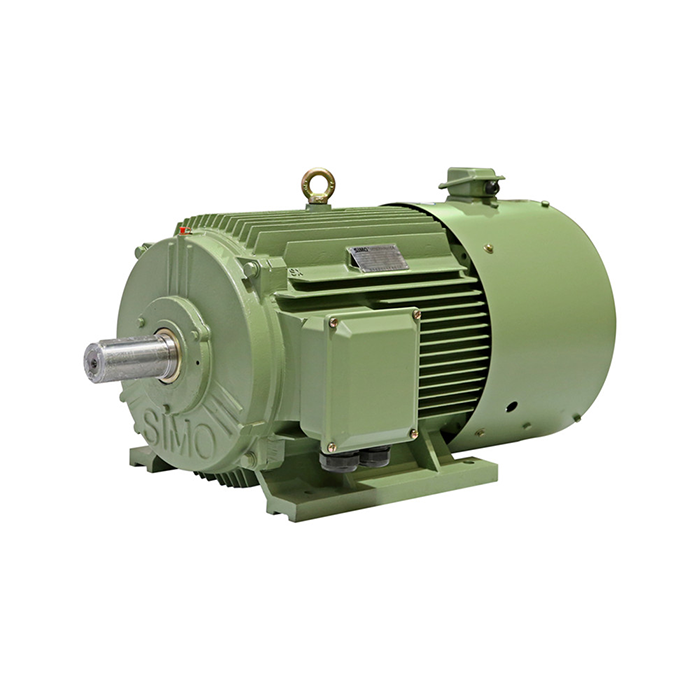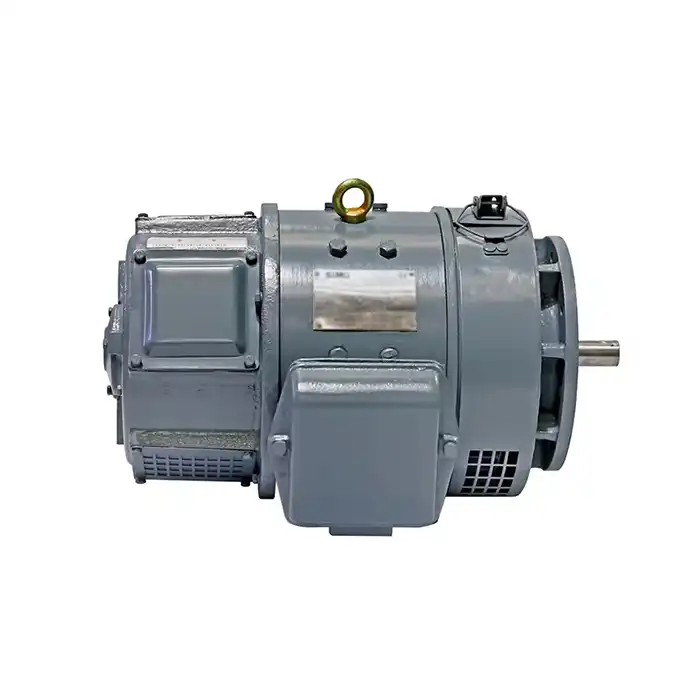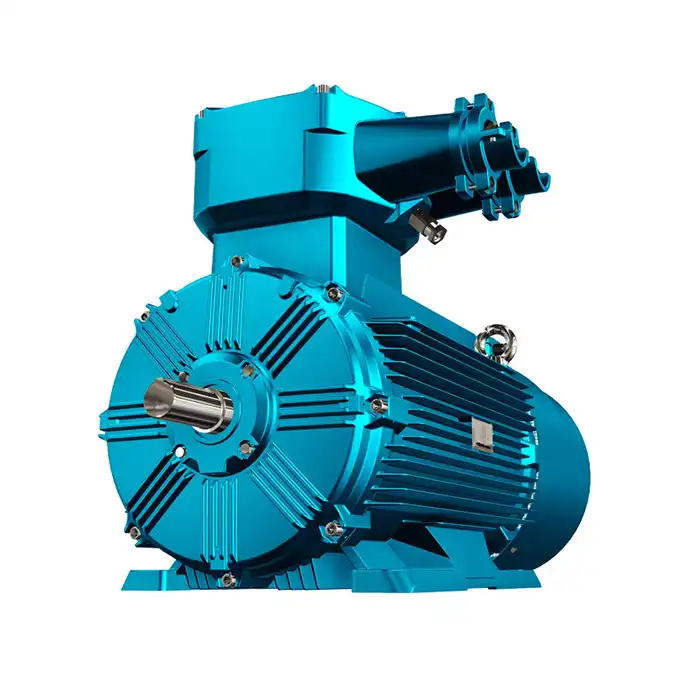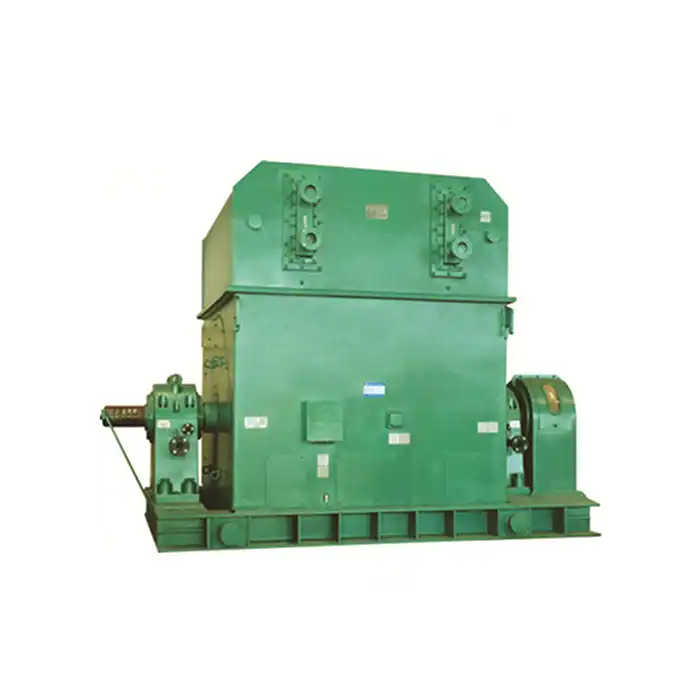To keep low-speed VFD duty motors running at peak efficiency and avoid thermal damage, certain cooling solutions are needed. Hybrid temperature management strategies, liquid cooling solutions, and improved air circulation systems are the most efficient cooling methods. In industrial automation settings, power needs might vary from 0.75 kW to 1000 kW, and these solutions make sure that VFD duty motors running at lower speeds dissipate enough heat while still providing a constant torque output throughout variable frequency ranges of 5 Hz to 100 Hz.

Series:YVFE5
Frequency conversion range:30hz~50hz,5hz~70hz,5hz~100hz
Power range:0.75-1000kW
Protection level:IP55
Application:are suitable for driving various mechanical equipment that require continuous and frequent forward and reverse rotation, such as steel rolling, lifting, transportation, machine tools, printing and dyeing, papermaking, chemicals, textiles, pharmaceuticals, etc., and can be used with various domestic and foreign variable frequency power supplies.
Advantage:high efficiency, wide speed range, high precision, stable operation, and easy operation and maintenance.
Certificate:installation dimensions comply with International Electrotechnical Commission (IEC) standards.
Others: SKF, NSK, FAG bearings can be replaced according to customer requirements.
Understanding the Importance of Cooling in VFD Motors
Variable recurrence drives make interesting warm challenges that require cautious thought in engine design and operation. When engines work at diminished speeds, the common cooling impact produced by rotor development diminishes significantly, leading to potential overheating issues that can compromise execution and longevity.
Why VFD Motors Require Cooling
The essential rule behind VFD engine cooling stems from the relationship between speed and warm era. At moo speeds, inner discuss circulation decreases, whereas electrical misfortunes stay significant. This combination makes an environment where warm amasses quickly than normal scattering can happen. Present-day VFD frameworks create consonant mutilations that deliver extra warm in engine windings, making compelling cooling indeed more basic for supported operation.
Temperature control becomes vital when considering the copper windings and silicon steel laminations utilized in high-quality engine development. These materials keep up their electrical properties within particular temperature ranges, and exceeding these limits can result in lasting harm to the motor's inside components.
Impact of Inadequate Cooling on Motor Performance
Insufficient cooling strategies lead to cascading performance issues that affect both immediate operation and long-term reliability. VFD duty motor windings operating above their design temperature experience increased resistance, which reduces overall system efficiency and increases energy consumption. This thermal stress accelerates insulation degradation, particularly affecting Class F and Class H insulation systems commonly used in industrial applications.
Research conducted by the Electric Control Inquiry about Organized shows that each 10°C increment in working temperature can diminish engine life by roughly 50%. This emotional effect on life span translates straightforwardly to expanded support costs and unforeseen downtime in basic mechanical processes.
Effective Cooling Techniques for Low-Speed VFD Motors
Selecting suitable cooling strategies depends on application prerequisites, natural conditions, and operational parameters. Each cooling approach offers unmistakable focal points that align with particular mechanical needs and budget considerations.
Air Cooling vs. Liquid Cooling: Pros and Cons
Air cooling frameworks represent the most common approach for VFD engine temperature administration due to their straightforwardness and cost-effectiveness. Completely Encased Fan Cooled (TEFC) plans give solid warm dissemination while keeping up IP55 security levels reasonable for most mechanical situations. These frameworks work effectively in applications where encompassing temperatures stay inside satisfactory ranges and space imperatives permit for satisfactory airflow.
Liquid cooling frameworks offer prevalent warm scattering capabilities, making them perfect for demanding applications where discuss cooling demonstrates deficiencies. Water or specialized coolant circulation through engine compartments or warm exchangers can keep up lower working temperatures indeed in challenging situations. Be that as it may, fluid cooling requires extra framework, including pumps, warm exchangers, and coolant administration frameworks, which increments starting investment and ongoing support requirements.
Innovative Cooling Systems for Enhanced Efficiency
Advanced cooling technologies incorporate intelligent temperature monitoring and adaptive cooling control systems. These innovations automatically adjust cooling intensity based on real-time temperature measurements and load conditions. Variable speed cooling fans that synchronize with VFD duty motor operation provide optimal heat dissipation while minimizing energy consumption.
Heat pipe innovation speaks to another imaginative approach, utilizing stage alter materials to exchange warm productively from engine windings to outside cooling surfaces. This inactive cooling strategy requires no extra control utilization while giving great thermal management for compact engine designs.
Optimizing Heat Dissipation in Low-Speed VFD Motors
Advanced temperature administration includes both dynamic cooling frameworks and detached plan changes that improve overall thermal performance. These comprehensive approaches address warm era at its source while maximizing scattering efficiency.
Advanced Temperature Management Techniques
Thermal modeling and prescient support innovations empower proactive cooling administration that anticipates overheating some time recently it happens. Savvy sensors coordinate into the engine plans screen, winding temperatures, bearing conditions, and surrounding components to optimize cooling system operation automatically.
Precision-balanced rotors and strengthened bearing frameworks contribute to warm administration by decreasing mechanical misfortunes that create pointless warm. High-quality SKF, NSK, and FAG bearings keep up reliable execution while minimizing friction-related temperature increases.
Long-term Benefits of Proper Heat Dissipation
Effective cooling methodologies amplify engine life expectancy essentially by decreasing support requirements and operational disturbances. Engines working inside plan temperature ranges keep up their appraised execution characteristics throughout their benefit life, giving steady torque yield and vitality efficiency.
Economic investigation illustrates that contributing in suitable cooling frameworks ordinarily recovers costs within 2-3 a long time through diminished upkeep costs and improved energy efficiency. The 10:1 consistent torque and 20:1 variable torque capabilities of appropriately cooled engines stay steady over amplified periods, keeping up framework productivity.
Industry-Leading VFD Motor Cooling Solutions
The advertisement offers various cooling arrangements outlined particularly for VFD applications. Understanding accessible alternatives and their execution characteristics makes a difference to buyers to make educated choices that align with their operational requirements.
Top Brands and Reliable Suppliers in the Market
Leading engine producers have created specialized cooling advances that address the special challenges of variable recurrence operation. These arrangements consolidate decades of investigate and field encounter to deliver dependable warm management over differing mechanical applications.
European and North American providers center on high-efficiency plans that meet rigid energy efficiency measures while giving vigorous cooling execution. Asian producers regularly emphasize cost-effective arrangements that provide solid cooling without premium pricing.
Evaluating VFD Motor Cooling System Reviews
User criticism reliably highlights the significance of the cooling framework unwavering reliability in basic applications. Fabricating offices report noteworthy enhancements in uptime and upkeep costs when updating to fitting cooling arrangements. Prepare control applications that especially advantage from steady temperature administration that keeps up exact operational parameters.
Performance reviews indicate that VFD duty motors with properly designed cooling systems maintain their rated specifications throughout their operational life, while inadequately cooled motors experience gradual performance degradation that affects overall system efficiency.
Integrating Our Expertise: XCMOTOR Solutions
XCMOTOR's comprehensive approach to VFD engine cooling combines demonstrated innovations with imaginative plan components that address the particular challenges of low-speed operation. Our YVFE5 arrangement engines join TEFC cooling frameworks optimized for variable frequency applications.
Our item line highlights engines with control ranges from 0.75kW to 1000kW, designed to work proficiently over frequency ranges of 5Hz to 100Hz. The IP55 security rating guarantees dependable operation in demanding mechanical situations while keeping up ideal cooling execution. Each engine joins high-quality silicon steel laminations and copper windings that work synergistically with our cooling frameworks to maximize warm dissipation.
Temperature rise classifications of Lesson B guarantee that our engines work inside secure warm limits, indeed during expanded low-speed operation. The C45 steel shaft development gives fabulous thermal conductivity while keeping up mechanical quality under shifting stack conditions.
XCMOTOR's commitment to quality extends beyond past item planning to comprehensive client support and specialized ability. Our engines comply with Universal Electrotechnical Commission (IEC) benchmarks, guaranteeing compatibility with worldwide mechanical frameworks. The capacity to customize bearing choices with SKF, NSK, or FAG components permits optimization for particular application requirements.
Our 30-day return approach and devoted specialized support give certainty in item determination and usage. Quick conveyance capabilities guarantee that basic applications get convenient access when cooling system overhauls become necessary.
Conclusion
Effective cooling methodologies for low-speed VFD engine operation require cautious thought of application necessities, natural conditions, and long-term operational objectives. The combination of a legitimate cooling framework determination, quality engine plan, and proactive upkeep guarantees dependable execution over differing mechanical applications. Venture in suitable warm administration arrangements conveys noteworthy returns through progressed productivity, expanded hardware life, and diminished upkeep costs. As variable recurrence drives innovation proceeds progressing cooling frameworks must advance to meet the progressively demanding requirements of advanced mechanical processes.
Frequently Asked Questions
Q1: What are the signs of overheating in a VFD motor?
A: Common pointers incorporate abnormal odors, over the top vibration, decreased torque yield, and increased energy consumption. Temperature observing frameworks can distinguish overheating some time recently; unmistakable indications show up, permitting preventive action to secure engine components.
Q2: How do I choose between air and liquid cooling for my VFD motor?
A: Consider the surrounding temperature, obligation cycle, and space limitations. Discuss cooling works well for direct conditions and discontinuous operation, whereas fluid cooling suits high-temperature situations and continuous operation applications requiring exact temperature control.
Q3: What maintenance is required for VFD motor cooling systems?
A: Regular cleaning of cooling fins and filters, fan inspection, and temperature monitoring ensure optimal performance. Liquid cooling systems require additional coolant level checks and pump maintenance according to manufacturer specifications.
Partner with XCMOTOR for Superior VFD Motor Solutions
For reliable operation in all kinds of industrial settings, rely on XCMOTOR, the VFD duty motor supplier that stands behind its products with state-of-the-art cooling solutions. Even during taxing low-speed operations, our knowledge of thermal management will keep your variable frequency drive systems running at top performance.
With a history of technical expertise spanning decades, Shaanxi Qihe Xicheng Electromechanical Equipment Co., Ltd. offers complete power equipment solutions. We are the go-to for HVAC, process control, and industrial automation because of our dedication to low power consumption, consistent power supply, and helpful customer service. Our staff provides the knowledge and quality you want for any thermal management solution, whether it's typical TEFC cooling or something more unique.
Ready to optimize your motor cooling strategy? Contact us at xcmotors@163.com to discuss your specific requirements. Our technical experts will help you select the ideal cooling solution for your application, ensuring maximum performance and longevity from your VFD motor investment.
References
1. Chapman, Stephen J. "Electric Machinery Fundamentals." 5th Edition. McGraw-Hill Education, 2012.
2. Boldea, Ion, and Syed A. Nasar. "Electric Drives." 3rd Edition. CRC Press, 2016.
3. Austin Hughes and Bill Drury. "Electric Motors and Drives: Fundamentals, Types and Applications." 4th Edition. Newnes, 2013.
4. Toliyat, Hamid A., and Gerald B. Kliman. "Handbook of Electric Motors." 2nd Edition. CRC Press, 2004.
5. Miller, T.J.E. "Electronic Control of Switched Reluctance Machines." Newnes, 2001.
6. Vas, Peter. "Sensorless Vector and Direct Torque Control." Oxford University Press, 1998.











